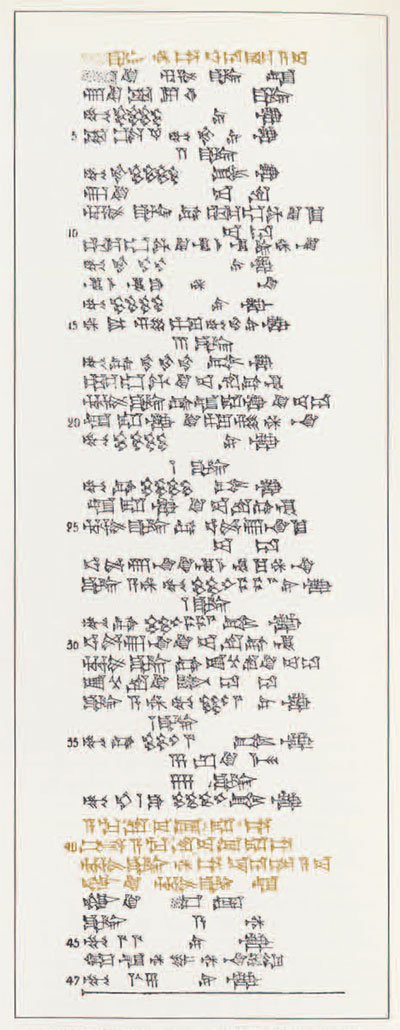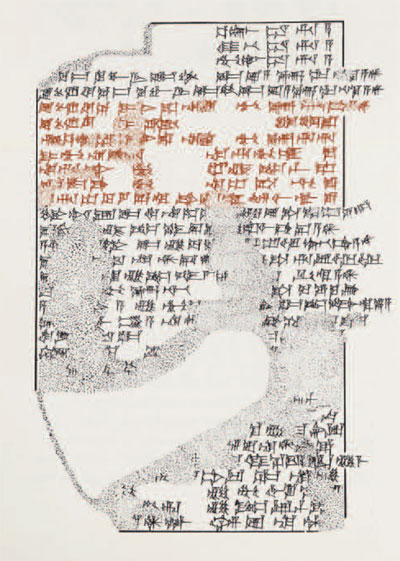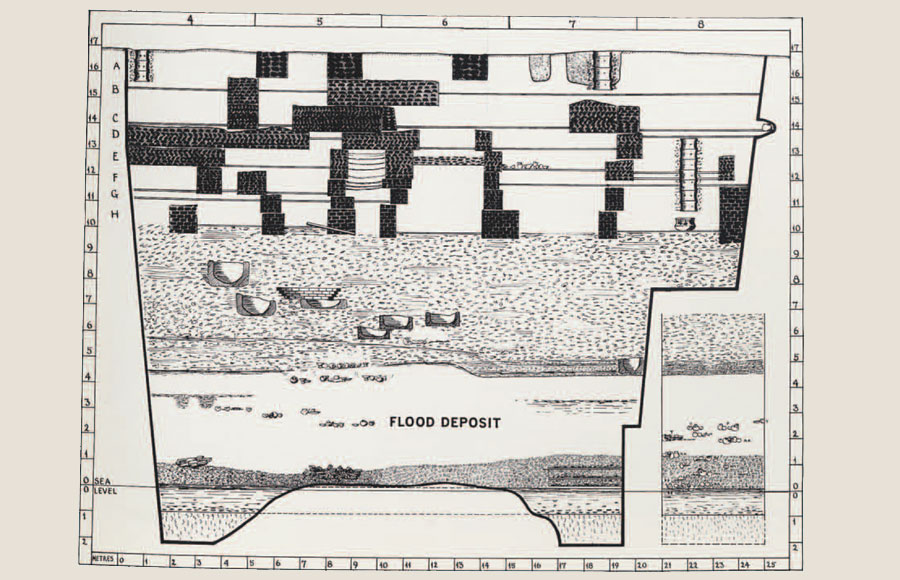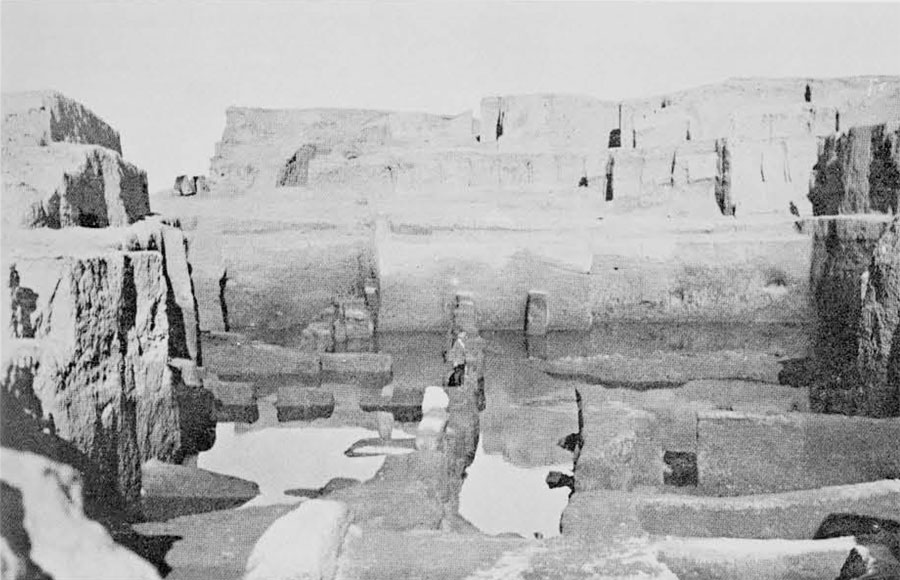Historiography, the writing of history, was hardly a favorite subject of the ancient Mesopotamian academicians and men of letters. Lacking the essential intellectual tools of definition and generalization, and immobilized by a sterile, static view of man and his past, they became at best archivists and chroniclers rather than interpreters and expositors of historical truths. Now one of the most valuable of the cuneiform chronicle-like documents that has as yet been dug up from the Mesopotamian soil is the so-called Sumerian “King List,” which records the dynasties and kings that held sway over much of Mesopotamia from the time when “kingship descended from heaven,” that is from the very beginning of history, down to the early second millennium B.C. To be sure, this unique document is actually a mixture of fact and fancy, and it is often difficult to decide where the one begins and the other ends. But in spite of its defects and shortcomings it provides us with an historical framework of inestimable value if utilized with discrimination and understanding. It is the very first section of this Sumerian “King List” that contains two brief passages of fundamental significance for the subject of this paper: the character and chronology of the Mesopotamian Flood as revealed in the available cuneiform material.

“After kingship had descended from Heaven,” begins our King List, there were five cities “before the Flood” whose eight fabulous kings ruled no less than 241,200 years. Following the hegemony of these five antediluvian cities, the document goes on to tell us:
The Flood swept over everything. After the Flood swept over everything, and kingship had (once again) descended from Heaven, Kish became the seat of kingship.
Little did the ancient scholar who “penned” these lines dream that this innocent-sounding passage would provoke heated debate and passionate controversy among his colleagues living and working more than four thousand years after he had departed for the Sumerian “Land of No-Return.” For what he seemed to say is that he knew of a real, historic, universal, catastrophic Deluge that had overwhelmed and destroyed not only Sumer, but mankind as a whole, a statement which most modern historians would hardly accept as credible and true. Still there are a few who, especially in view of the Biblical account of the Deluge that has been part and parcel of Judaeo-Christian tradition for thousands of years, would like to think of it as an authentic event that had taken place in the far distant past. And even among the skeptics, there are some who feel that there must be at least a kernel of truth in the Flood-motif; it seems to have played too large a role in Mesopotamian myth and legend for it to have been nothing more than a total fabrication of fancy and fantasy.

Museum Object Number(s): CBS10673
It was just a little over a hundred years ago, on December 3, 1862, to be exact, that an Englishman by the name of George Smith who had been studying thousands of clay tablets and fragments brought to the British Museum from Ancient Nineveh, read a paper before the Society of Biblical Archaeology, in which he announced the discovery and decipherment, on one of the clay tablets dug up from the long buried library of King Ashurbanipal, of a version of a Deluge myth that showed marked resemblances to the Flood of the Book of Genesis. The document has since been studied by a whole host of scholars, and the story it tells is now known to be as follows:
Once upon a time the gods, whose peace was disturbed by the “noisy,” that is, sinful deeds of man, decided to send a Flood that would destroy him utterly and wipe him off the face of the Earth. But Ea, the kindly god of wisdom, was unhappy with this cruel decision; he felt that only the transgressor should suffer for his sins and not all mankind. He therefore reveals the decision of the gods to Utanapishtim, a king of Shuruppak, who not unlike the Biblical Noah, was a good, wise, and god-fearing man, and instructs him to build a huge, ziggurat-like boat, and load it with all his possessions, his family and kin, the beasts of the field, and all sorts of craftsmen. Utanapishtim followed the directions in every detail, and when the Flood came, he boarded the ship, and put it in charge of a trusty sea-captain by the name of Puzur-Amurri. For six days and sic nights the Flood-winds blew over the land and the South-wind tempest swept over it. On the seventh day, the winds subsided, the sea grew still, and the Flood ceased. But when Utanapishtim looked out, he saw that the landscape was flat and bare and that all mankind had “returned to clay.” With tears running down his cheeks, he saw that the land had turned into a vast sea. Here and there, however, the top of a mountain was visible, and on one of these, Mt. Nisir, generally identified with Mt. Ararat in Eastern Anatolia, the boat found a resting place. Still, Utanapishtim was unable to leave his “ark,” until he was sure that the land had become dry again. He sent forth first a dove, and then a swallow, but both returned to the boat for safety. Utanapishtim then set free the raven, and when this bird failed to return, he took it as a sign that the land had become sufficiently dry for human habitation. With joyous thanksgiving, Utanapishtim then proceeded to offer sacrifices and pour libations to the gods who “smelled the sweet savor” of his offerings with deep satisfaction and Enlil, their king, then proceeded to bless him and his wife saying:
Until now Utanapishtim was mortal,
Henceforth, Utanapishtim and his wife shall be like the gods,
Utanapishtim shall dwell in a faraway land, at the mouth of the rivers.
The Flood legend sketched above is inscribed in the cuneiform script, but in the Semitic language commonly known as Assyrian or Babylonian. The Sumerian version of this story was unknown until 1914 when my teacher and colleague, the distinguished Sumerologist, Arno Poebel, published a copy and translation of a tablet excavated some time between 1889 and 1900 at Nippur, Sumer’s holy city. Only the lower third of the tablet is preserved—scholars have searched in vain for possible duplicates in the museums and private collections the world over—and it still remains our sole source for the Sumerian version of the Deluge myth. Fragmentary as it is, however, the Flood story it tells can be reconstructed in large part, thus:

Sometimes after the gods had created man, plants, and animals, and kingship had been established in five special cult centers, they decided to bring the Flood and destroy mankind—the passage giving the reason for this melancholy judgment is broken away, but no doubt it was some act of hubris or disobedience on the part of man. But, the tale continues, some of the gods were unhappy with the extreme severity of the decree, and one of them, Enki, who is none other than the Ea of the Babylonian version, reveals it to Ziusudra, the Sumerian counterpart of the Babylonian Utanapishtim, and counsels him to build a giant boat to ride out the tempestuous Flood and so save his own life and “the seed of mankind.” Ziusudra faithfully follows the god’s directions, and is delivered from destruction, or as the poet puts it:
After, for seven days and seven nights,
The Flood had swept over the land,
And the huge boat had been tossed about by the windstorms on the great waters,
Utu (the sun-god) came forth, who shed light on heaven and earth,
Ziusudra opened a window in the huge boat,
The potent Utu brought his rays into the giant boat.
Ziusudra, the king, prostrated himself before Utu,
The king kills an ox, slaughters a sheep…
Following a break in the text, we find Ziusudra prostrating himself before An and Enlil, the two leading gods of the Sumerian pantheon, who are so pleased with his god-fearing humility that they give him “life like a god,” and breath eternal, and translate him to Dilmun, the Divine Paradise, “the place where the sun rises.”

This is all that was known about the Sumerian Flood until 1964. In the summer of that year I was working in the Student Room of the Western Asiatic Section of the British Museum when the keeper in charge of its far-famed tablet collection, Edmond Sollberger, brought me some sixty tablets bought by the museum many years ago, inscribed with a humber of hitherto unstudied Sumerian literary works. Among these were two beginning with “Flood” passages. The first is inscribed with an as yet unknown myth about the birth of the numun plant, the reedy rushes that played no little role in Sumerian daily life. Its initial lines which set the scene for the tale as a whole read:
After the storm had brought the rains,
After (all) built walls had been destroyed.
After the raging tempest had brought the rains,
After the giba-man had been raised up as rival against man;
After the seed had been implanted—
yes implanted,
After the grain had been engendered—
yes, engendered,
After the storm had said:
“I will bring the rains,”
After he had said:
“I will bring down the rains on the built walls,”
After the Flood had said:
“I will wipe out everything.”
Heaven commanded, Earth gave birth,
Gave birth to the numun plant.
Earth gave birth, Heaven commanded
Gave birth to the numun plant.
The second tablet was to some extent even more intriguing; it was inscribed with a document that purported to give an outline sketch of the growth and development of the city of Lagash from earliest times to the days of Gudea, the ruler whose face and features are now so well known from the numerous statues excavated by the French at that ancient city. It is the introductory passage to this pseudo-historical composition that concerns the Flood and reads:
After the Flood had wiped out (everything),
After the destruction of the lands had been achieved,
After mankind was made (to endure)forever,
After the seed of mankind had been saved,
After the black-headed people (the Sumerians) had of themselves been lifted high,
After An and Enlil had called man by name,
After ensi-ship (had been established)
But kingship…
Had not yet descended from heaven…

So much for the cuneiform literary works documenting the Flood. All in all they justify the conclusion that the Mesopotamian minstrels and poets knew of a catastrophic Deluge that had done immense damage to the land and its people, but from which it eventually recovered, and that it was this unforgettable disaster together with its “happy ending,” that inspired them to create and develop over the centuries a universal Flood-myth that was appealing, entertaining, and in accord with their religious world view. That this took place in Mesopotamia, and particularly in its southern half, the Sumer of most ancient days, is not surprising, for it is a region where torrential floods are endemic to this day. There was one such appalling disaster for example, in 1954, when an exceptionally rainy spring combined with the melting snows of Armenia and Kurdistan, so swelled the Tigris River that it submerged the low-lying plain for hundreds of miles, and all Baghdad was in imminent danger of destruction. Max Mallowan, the distinguished British archaeologist who, when a young man, was one of Leonard Woolley’s associates in the excavation of Ur, reports that from 1925 to 1930,
there was hardly a season either in the spring or autumn, when the desert did not, at least for a few days, assume the appearance of a lake, and quite often Eridu (some 12 miles to the southeast) was cut off from us. I remember a day in the month of November, either 1925 or 1926, when in a torrential downpour we had to use our two hundred workmen to complete a dyke across the courtyard of our expedition house in order to save it from being swept away; within a few minutes of this cloud-burst, we were standing chest-deep in water outside our own front door.
There are historical references to violent floods in Southern Mesopotamia going back to Abbasid days of the seventh and eighth century A.D., as well as to tenth, eighteenth, and twentieth century B.C., and there were certainly many more of which we have no record. As for the date of the catastrophic event on which the Sumerian Flood-myth is based, this will obviously depend on the date ascribed to its hero Ziusudra. Unfortunately we have as yet no authentic, contemporary historical records of his life and times. But the fact is that there is a version of the Kind List which lists him as the king of Shuruppak immediately before the Flood. Moreover, as has long been known, he was an important figure in Sumerian historical and literary tradition, a ruler noted for his wisdom and perspicacity, as is befitting a hero who somehow managed to escape an overwhelming disaster, such as the Flood. Thus, we have a Sumerian wisdom document known as “The Instructions of Shuruppak to his son Ziusudra,” which begins with the lines:
Shuruppak gave instructions to his son,
Shuruppak, the son of Ubartutu,
Gave instructions to his son Ziusudra:
“My son, I would instruct you,
Take my instructions,
Ziusudra, I would utter a word to you,
Give heed to it,
Do not neglect my instruction,
Do not transgress the word I uttered,
The father’s instructions, the precious,
Carry out diligently.”

Now until recently these lines were known only from tablets dated as late as the first half of the second millennium B.C. But two years ago, the Oriental Institute of the University of Chicago, while excavating the ruins of Salabih, a city some twenty kilometers northeast of Nippur, whose ancient name is still unknown, discovered a tablet inscribed with a version of “The Instructions of Shuruppak” that can be dated to about 2500 B.C. The name of Shuruppak’s son is not actually stated in the text, but it may well turn out to be Ziusudra. In any case, it is fairly certain that Ziusudra had become a venerable figure in literary tradition by the middle of the third millennium B.C., it is not unreasonable to conclude that he lived some centuries earlier, and we may therefore date his reign, as well as the Flood that presumably occurred in his days, to the early third millennium B.C., not long after kingship had come into vogue. But if so, if a catastrophic deluge of immense destructive force had actually come upon the land close to 3000 B.C., there should be some corroborative archaeological evidence from some of the more important excavated sites in Sumer. And this is actually the case; in the past forty years quite a number of significant discoveries relating to the “archaeology of the Flood” have been made, but their interpretation has been a source of considerable controversy and debate.
The key figure in the archaeological Flood debate, the excavator who staked first claim to the discovery and identification of a Flood stratum is Leonard Woolley. In 1929, after he had completed excavating the Royal Cemetery of Ur with its extraordinary and dazzling finds, he sank a small shaft, not more than five feet square at the top, into the underlying soil. For about three feet, this shaft penetrated a layer of mixed rubbish typical of inhabited sites—decomposed mud-brick, ashes, and broken pottery. But then, to use the excavator’s own words:
it all stopped—there were no more pot—sherds, no ashes, only clean, water-laid mud, and the Arab workman at the bottom of the shaft told me that he had reached virgin soil; there was nothing more to be found, and he had better go elsewhere (Leonard Woolley, Excavations at Ur, page 26).
Woolley, however, noted that this so-called virgin soil was not nearly as deep down as he had expected, and he told the worker to keep on digging. He did so rather grudgingly, and went through eight feet of absolutely clean soil, without any sign of human activity. Suddenly, immediately below this “empty” stratum, there appeared pottery vessels and stone implements readily recognizable as belonging to the prehistoric Ubaid period of occupation. Woolley was convinced then and there that he had the “Flood.” But since he could scarcely argue convincingly for the Deluge on the strength of a pit a yard square, he dug the following season a rectangle some seventy-five feet by sixty and went down sixty-four feet deep. And here, too, above the Ubaid remains, he found a deposit of clean, water-laid soil, this time eleven feet thick. All in all Woolley sank fourteen pits at various points down to sea-level, or approximately so, and in virtually every case he encountered some clean water-laid soil overlying Ubaid remains. He therefore concluded that he had found the Flood-myth archaeologically verified at Ur.
Unfortunately that matter was not so simple and clear-cut as Woolley assumed; his Flood deposits at Ur go back to at least 3500 B.C., and this is far too early for the Ziusudra Deluge. Moreover, the year before Woolley staked his claim for Ur, Stephen Langdon and L. Watelen, the excavators of Kish, had discovered a Flood layer that was chronologically in closer agreement with Ziusudra’s date; it lay directly above a stratum of “Jemdet Nasr” remains, that is an archaeological horizon ranging from about 3200 to 3000 B.C. first identified in Jemdet Nasr, a small mound not far from Kish. Even more intriguing and apropos was a similar discovery in 1931 by Eric Schmidt of a Flood level immediately above Jemdet Nasr remains in Ziusudra’s own city, Shuruppak. All in all, therefore, it is justifiable to conclude from the present evidence, as does Max Mallowan in his recent thoughtful and comprehensive article, “Noah’s Flood Reconsidered” (Iraq, vol. XXVI, 1964, pages 62-83) that the Mesopotamian Flood-story, and the Old Testament version based on it, was inspired by an actual catastrophic but by no means universal disaster that took place, not as Woolley claimed, immediately after the Ubaid period, but some time about 3000 B.C., and that it left its archaeological traces in Kish, Shuruppak, and probably at a good many other places yet to be discovered.
